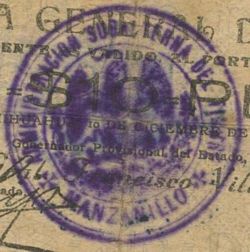Circulation of other Constitutionalist issues
The Constitutionalist issues, such as the Gobierno Provisional de México notes, were used in the state and so the authorities relayed Carranza’s decrees and made other pronouncements.
In August 1914 the new Constitutionalist government published Carranza’s earlier decrees, including the circular núm. 6 of 7 October 1913 disowning later Banco Nacional de México notes, which Carranza had rescinded when he took over the federal government. This naturally caused great alarm so on 26 August governor Eduardo Ruiz published a clarification thatthe decree had been rescindedEl Popular, Colima, Epoca Tercera, Núm. 37, 27 August 1914. On 3 September it was reported that the federal offices would receive all banknotes and Obligaciones ProvisionalesEl Popular, Colima, Epoca Tercera, Núm. 44, 3 September 1914 and this was confirmed three days laterEl Popular, Colima, Epoca Tercera, Núm. 47, 6 September 1914 and again, another three days laterEl Popular, Colima, Epoca Tercera, Núm. 50, 9 September 1914.
On 22 September it was reported that contrary to rumours to date the government had not received any information about counterfeit $5 notes (los Billetes de Cinco pesos emitidos por el Gobierno Constitucionalista), either of the Gobierno Provisional de México or Monclova issue, and so they were all good and of forced circulationEl Popular, Colima, Epoca Tercera, Núm. 60, 22 September 1914. On 30 September, as businesses were frequently refusing to accept certain notes, they were told that they were all good and that anyone refusing would be severely punishedEl Popular, Colima, Epoca Tercera, Núm. 67, 30 September 1914.
Some sábanas also reached the state. On 12 December 1914 the Governor, Miguel Orozco, issued a circular that people had until 25 December to present their sábanas in the Administración Principal del Timbre for revalidation. The offices would be open from 10.00 till 12.00 in the morning and 3.00 to 4.00 in the afternoonPeriódico Oficial, Tomo XLVIII, Núm. 48, 19 December 1914. However, Carranza had already issued his decree nullifying the Chihuahua issues on 27 November and this was transmitted to the Interim Governor Esteban B. Calderón, via Zapotlán, and published in the Periódico Oficial of 28 DecemberPeriódico Oficial, 28 December 1914. Presumably the news will have been common knowledge before then, so there was a maximum of a few days, for three hours a day, when the known resello, ‘Administracion Principal de Timbre, Colima’, could have been applied.
 There is also a round (42mm) purple seal with ‘ADMINISTRACION SUBALTERNA DEL TIMBRE – MANZANILLO’ from Manzanillo, the main port of the state. This was probably used in December 1914, at the same time as the Colima resello above.
There is also a round (42mm) purple seal with ‘ADMINISTRACION SUBALTERNA DEL TIMBRE – MANZANILLO’ from Manzanillo, the main port of the state. This was probably used in December 1914, at the same time as the Colima resello above.
On 19 July 1915 when the old tesorero municipal handed over to the new one, there were $8,708.34 in the safe, made up of $2,042.89 in notes in good condition and of legal tender, $1,570.90 in a vale dated 11 August 1914 signed by the former Tesorero, Ramón Castillo, and $5.094.55 in notes that were deteriorated or no longer in circulationAMCol, legajo 61, exp. 3. An analysis of the later (with some assumptions) shows where the notes originally came from:
| billetes of Durango | $1,973.20 |
| sábanas | 1,247.50 |
| Riveros, Sinaloa | 671.25 |
| bonos of Colima | 352.25 |
| Murguia, Uruapam | 295.00 |
| cartones | 144.40 |
| bonos of Durango | 81.00 |
| bonos of Jalisco | 24.05 |
| Monclova | 16.00 |
| Obregón, Tepic | 7.50 |
| Estado de Sonora | 6.00 |
| Ejército Constitucionalista | 5.00 |
| Counterfeit Ejército Constitucionalista (fondo blanco) | 250.00 |
| Iturbe | 4.00 |
| Obligaciones Provisionales | 3.00 |
| Guaymas, Sonora | 2.40 |
| unidentified | 12.00 |
On 20 October 1915 the Presidente Municipal of Colima, Carlos G. Rosando, printed flyers outlining the procedure for the withdrawal of Gobierno Provisional de México notes, which had again been extendedAMCol, 61, exp. 3.
